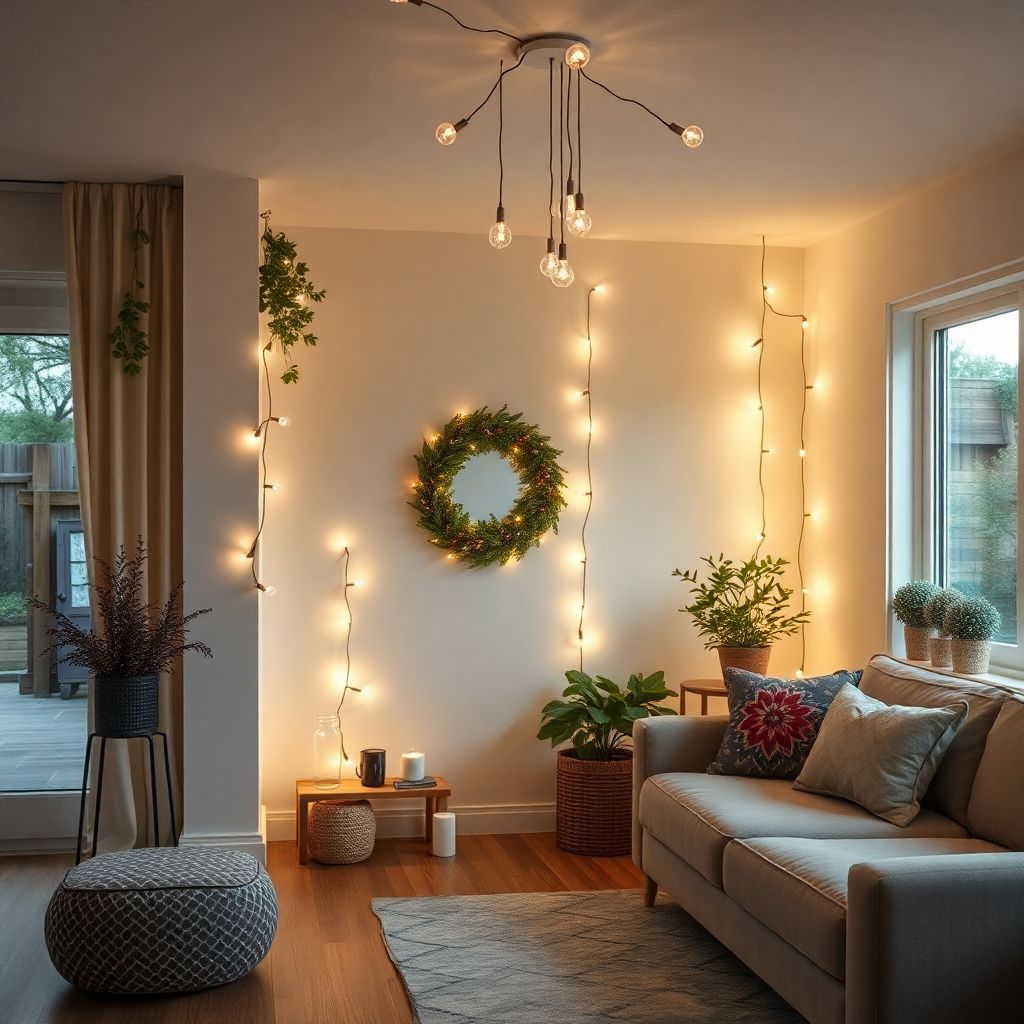Buy this domain
Imagine walking into a room. It feels flat. Boring, even. But with light? That same space bursts to life. Light can shift the mood and add beauty. It’s a powerful design tool. You can use it to change how your home looks and feels.
Light is more than just brightness. It’s a design choice. It reshapes rooms. It makes your favorite things pop. Light also affects how you feel. So, let’s explore how to decorate with light. We’ll look at different kinds of lighting. We’ll discover how to use them to enhance your home.
Understanding the Fundamentals of Lighting Design
Good lighting design is key to great home decor. Think of it like the backbone of your interior. It needs careful thought. You have to consider types, colors, and layers.
Types of Light: Ambient, Task, and Accent
There are three main types of lighting. These are ambient, task, and accent.
- Ambient lighting is your general light. It fills the room. Think of ceiling fixtures or recessed lights.
- Task lighting helps you do things. Under-cabinet lights for cooking? A desk lamp for reading? Those are task lights.
- Accent lighting highlights things. Maybe you have art you love. Or cool architectural details. Accent lights make them stand out.
Color Temperature and Its Impact
Color temperature matters too. It’s measured in Kelvin (K). Lower Kelvin numbers mean warmer light. Think cozy, yellow tones. Higher Kelvin means cooler light. These are brighter and whiter.
For bedrooms, go warm. Around 2700K to 3000K is nice. Kitchens and offices can use cooler light. Something around 3500K to 4000K works well.
Layering Light for Depth and Dimension
Layering light is like making a cake. You need all the parts. You need ambient light to set the mood. You need task lighting to be useful. Then, accent lighting adds that final touch. All of them together create a balanced and inviting space.
Choosing the Right Light Fixtures for Your Style
The right light fixtures boost your home’s style. They’re not just for light. These are design statements.
Chandeliers and Pendants: Making a Statement
Chandeliers and pendants grab attention. They add elegance. A fancy chandelier works well in a dining room. Pendants are cool over kitchen islands. Choose styles that match your home. Modern? Go for sleek lines. Classic? A crystal chandelier could be nice.
Lamps: Versatility and Functionality
Lamps are super useful. They come in all shapes and sizes. Table lamps are great for side tables and desks. Floor lamps can fill empty corners. Pick lamps that fit the space. A tall floor lamp works well in a big living room. Smaller table lamps suit bedrooms.
Recessed Lighting and Track Lighting: Subtle Illumination
Recessed lights are hidden in the ceiling. These provide clean, even light. Track lighting lets you aim light where you need it. Use them to highlight artwork or shelves. Both are good choices for modern homes. They’re simple and functional.
Room-by-Room Lighting Strategies
Each room needs a unique lighting plan. Think about how you use each space. Then, choose lights that fit.
Living Room: Creating a Cozy and Inviting Atmosphere
Living rooms need layered lighting. Start with ambient light. Then add task lighting for reading. Accent lights can highlight your decor. A mix of lamps and overhead lights makes the room cozy. Use dimmers to control the mood.
Kitchen: Balancing Functionality and Aesthetics
Kitchens need bright task lighting. You want to see what you’re doing while cooking. Under-cabinet lights are a must. Add ambient lighting with recessed lights. Pendant lights over the island can be stylish.
Bedroom: Promoting Relaxation and Rest
Bedrooms should be relaxing. Use soft, warm lighting. Bedside lamps are perfect for reading. Dimmers let you adjust the brightness. Avoid harsh overhead lights. A calm, dim room helps you sleep.
Smart Lighting and Energy Efficiency
Smart lighting saves energy and adds convenience. LED bulbs are a good choice too. They last longer and use less power.
The Advantages of Smart Lighting Systems
Smart lights are easy to control. You can change the brightness from your phone. Some even change color. Set timers to turn lights on and off. This makes your home safer and saves energy.
LED Lighting: A Sustainable Choice
LED bulbs use way less power than old lights. They also last much longer. This saves you money and helps the planet. Switch to LED to be more eco-friendly.
Maximizing Natural Light
Natural light is great. It makes rooms feel bigger and brighter. Use light-colored paint to bounce light. Mirrors can also spread light around. Keep windows clean. Don’t block them with heavy curtains.
Common Lighting Mistakes and How to Avoid Them
Lighting mistakes can ruin a room. Avoid these common problems.
Glare and Shadows: Achieving Balanced Illumination
Too much glare hurts your eyes. It can cause shadows. Use lampshades to soften the light. Diffusers can also reduce glare. Place lights where they won’t shine directly in your eyes.
Overlighting and Underlighting: Finding the Right Balance
Too much light can feel harsh. Not enough light makes a room gloomy. Layer your lighting to get it just right. Use dimmers to adjust the brightness as needed.
Ignoring the Color Rendering Index (CRI)
CRI tells you how well a light shows colors. A high CRI means colors look real. Choose bulbs with a CRI of 80 or higher. This makes your home look better.
Conclusion
Light is a key part of home design. Good lighting reshapes spaces. It enhances decor. And it affects how you feel. Experiment with different lights. Transform your home into a beautiful and useful space. Thoughtful lighting makes a big difference. It enhances your home’s look and feel.
